As the year draws to a close—a time often filled with reflection and transformation—I’m resharing one of the most resonant posts from my archives.
Since I wrote the piece a few years ago, its personal meaning has grown even stronger. The more I commit myself to a life fully lived, the more deaths I experience—each an opportunity for rebirth and growth.
The piece not only captured the hearts of many but also evolved into a full chapter in my book, Awaken Your Genius.
And remember: The Kindle version of Awaken Your Genius is on sale for just $3.99 in the U.S., but only until this Sunday, December 24th. The book has been a catalyst for transformation for countless readers, and now it’s available to you for less than a cup of coffee. Get your copy here.
—
To become a butterfly, the caterpillar must accept its own death.
The process begins when an impulse deep within the caterpillar signals that it’s time for a radical change. When that signal arrives, the caterpillar hangs itself upside down from a twig or a leaf and forms a chrysalis.
Inside the chrysalis, the caterpillar begins to literally eat itself, emitting enzymes to dissolve and digest all its tissues. The only survivors are a group of cells called imaginal discs—whose name comes from the word imagination.
Fed by the nutritious soup inside the chrysalis, these discs allow the caterpillar to develop eyes, wings, legs, and everything else it will need to become a butterfly. Out of that disgusting mess, a marvelous butterfly emerges.
My time for metamorphosis arrived back in 2016. Shortly after I got tenure as a professor, I realized that this life was no longer for me. I didn’t want to write academic articles that only a handful of professors would read. What’s more, I had been teaching the same classes, answering the same questions, and attending the same committee meetings for years.
My life as a caterpillar had become comfortable—too comfortable. I had stopped learning and growing.
So I decided to spin myself into a chrysalis and digest my past as fuel for my future. My former career in rocket science provided me wings for critical thinking—and formed the subject matter for a book. Academia provided the legs for teaching and captivating audiences. A decade of writing gave me the antennae for storytelling. These imaginal discs helped me to create the new me.
There’s birth in death. As Joseph Campbell writes, “The earth must be broken to bring forth life. If the seed does not die there is no plant. Bread results from the death of wheat. Life lives on lives.”
Yes, life lives on lives. Our old selves become compost for our new selves. Our old truths become seeds for new revelations. Our old paths become lighthouses for new destinations.
Letting go doesn’t mean forgetting. Quite the opposite: Letting go requires remembering the gifts of the past and the clues the caterpillar left you to navigate life as a butterfly.
Steps forward often require steps down. “Our next life,” Glennon Doyle writes, “will always cost us this one. If we are truly alive, we are constantly losing who we just were, what we just built, what we just believed, what we just knew to be true.” Any real change requires you to die before you die—and know that dying can be the beginning, not the end.
You may not know it yet, but you’re walking around with imaginal discs within you ready to sprout a butterfly. Say thank you to the caterpillar and let it go. Let what’s dying serve as fertilizer for what’s awakening.
As you emerge out of your chrysalis, the possibilities will appear endless. You’ve got wings, and you can fly in a million different directions.
You can look at that infinite abyss and feel paralyzed. Or you can loosen your grip on your past and see where the universe leads you—wingbeat by curious wingbeat.
As Rumi writes, as you start to walk out on the path, the path will appear.
And remember: The Greek word for butterfly is psyche. And psyche means soul.
When you undergo a metamorphosis, you won’t lose yourself.
You’ll discover the depths of your soul.
Bold



